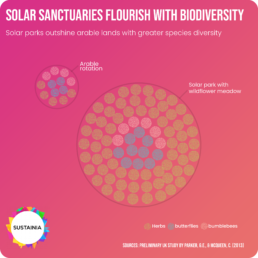Sustainia Simplifies
Nature-friendly
solar parks

Preserving Nature, Harnessing Energy: The Promise of Nature-Friendly Solar Parks
Nature-friendly solar parks can benefit both climate and biodiversity. By making use of the park area not used for infrastructure to provide diverse habitats for a variety of wildlife, solar parks can offer a cost-effective, long-term investment that enhances biodiversity and reduces greenhouse gas emissions. Here, planning and local involvement is essential for success.
Two years ago, a joint IPBES–IPCC workshop report was released as part of the first-ever collaboration between the two intergovernmental bodies, drawing attention to the interconnected and reinforcing nature of climate and biodiversity. While this is by no means a new discovery, the call for combined efforts which tackle both in a synergic manner comes at a time when the European Union (EU) is moving at full speed towards renewable energy – an endeavour that will likely require vast areas of land.
Enter nature-friendly solar parks
Several models of renewable energy parks offer effective recipes for supporting wildlife and increasing biodiversity without delaying the accelerated transition towards renewables. In fact, a recent white paper published by SolServices on next-generation solar parks showcases how, with appropriate plant cover and management, solar parks can “provide an almost undisturbed habitat for both flora and fauna for some 30 years after construction.” In light of this, so-called nature-friendly solar parks make for a cost-effective, long-term investment contributing to the dual efforts of boosting biodiversity and cutting greenhouse gas emissions, with benefits extending beyond the project lifetime.
For the vast majority of solar parks we see today, less than 5% of the area is physically covered by infrastructure such as roads, inverters and support poles for panels. The other 95% not covered by infrastructure and partially shaded by the panels can be harnessed to provide diverse habitats for plants and animals. Here, SolServices’ white paper outlines some methods and considerations for creating a more natural vegetation cover to benefit a wide variety of wildlife, from pollinators and amphibians to birds, bats, rodents, and even big game.
More precisely, flower meadows, including a diverse range of plants that flower at different times of the year, have proven to be particularly beneficial to pollinating insects and require little resource-intensive maintenance once ecological balance has been reached. Shrubs and hedges – so long as they do not interfere with energy production and emergency regulations – provide safe passages and shelter for small animals. Beyond offering a stable habitat and food source for various animals, the established vegetation (ideally comprising diverse native and indigenous plants) is largely self-sustaining by helping prevent soil erosion, reduce evaporation and lower soil surface drying, with deep roots transporting minerals and nutrients to increase soil fertility.
Perhaps unsurprisingly, the nature-friendly component lies not only in the final design of the solar park but appears much earlier in the planning process. This is especially true for identifying the site itself, where appropriate assessments of the basic natural characteristics and ecological status of the area help ensure that projects do not adversely affect the site’s integrity.
Similarly, the European Commission recently released the REPowerEU Plan, requiring governments across Europe to identify dedicated ‘go-to’ areas for renewable energy installations with special regard to wider regional and national plans to protect and restore ecosystems. Specifically, this includes EU obligations on protected and strictly protected land areas, Natura 2000 sites, and other protected areas and nature restoration sites.
Collaborate with the locals
While many freely accessible databases – including the European Commission’s Energy and Industry Geography Lab – offer such information, consulting with local authorities and stakeholders may provide additional insights while fostering local support for the project. To be sure, local authorities and stakeholders are often better equipped with site-specific knowledge to ensure that no plant or animal species are introduced that can negatively impact any surrounding natural or agricultural land.
The benefits of engaging with local stakeholders are not limited to access to detailed site information, either. Such collaboration further grants access to resources and tools which help create a suitable vegetation cover. To name a few examples, the productivity of flower-rich grasslands can be boosted by installing beehives within or near the park, perhaps with the help of local beekeepers. Moreover, ecologists and botanists can support the propagation of native and indigenous plant species from nearby natural grasslands or other local sources.
In the end, there are a variety of strategies and tools for planning, designing and managing solar parks in a way that harmonizes energy generation with biodiversity. Still, it goes without saying that a collaborative approach may be particularly valuable in minimizing risks and ensuring effective roll-out and long-lasting benefits. Such collaboration is not limited to engagement with local stakeholders and authorities; projects can further channel support from national or regional actors through public-private partnerships (PPPs). Indeed, the REPowerEU Plan places national governments as key players in the roll-out of renewable energy projects, facilitating seamless permitting processes and possible access to public funding.
As a result of the increasing affordability, efficiency, and lifetime of solar panels, we will likely see the global installed PV capacity increase almost twenty-fold by 2050. In the heat of the current policy setting, driven by the EU Green Deal and international treaties like the United Nations Framework Convention on Climate Change (UNFCCC) and Convention on Biological Diversity (CBD), nature-friendly solar parks offer a refreshing avenue towards boosting renewable energy generation and cutting greenhouse gas emissions, all while conserving the Earth’s biodiversity.
